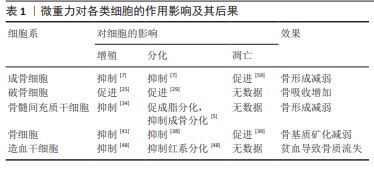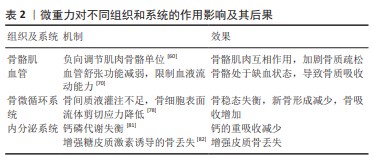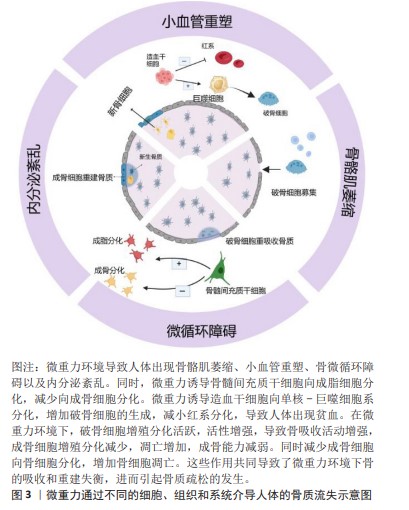[1] LAMBERS FM, SCHULTE FA, KUHN G, et al. Mouse tail vertebrae adapt to cyclic mechanical loading by increasing bone formation rate and decreasing bone resorption rate as shown by time-lapsed in vivo imaging of dynamic bone morphometry. Bone. 2011;49(6):1340-1350.
[2] SIDDIQUI JA, PARTRIDGE NC. Physiological bone remodeling: systemic regulation and growth factor involvement. Physiology (Bethesda). 2016;31(3):233-245.
[3] LI L, ZHANG C, CHEN J, et al. Effects of simulated microgravity on the expression profiles of RNA during osteogenic differentiation of human bone marrow mesenchymal stem cells. Cell Prolif. 2019;52(2):e12539.
[4] PAN Z, YANG J, GUO C, et al. Effects of hindlimb unloading on ex vivo growth and osteogenic/adipogenic potentials of bone marrow-derived mesenchymal stem cells in rats. Stem Cells Dev. 2008;17(4):795-804.
[5] ZHANG C, LI L, JIANG Y, et al. Space microgravity drives transdifferentiation of human bone marrow-derived mesenchymal stem cells from osteogenesis to adipogenesis. FASEB J. 2018;32(8):4444-4458.
[6] PARDO SJ, PATEL MJ, SYKES MC, et al. Simulated microgravity using the random positioning machine inhibits differentiation and alters gene expression profiles of 2T3 preosteoblasts. Am J Physiol Cell Physiol. 2005;288(6):C1211-C1221.
[7] BRAVEBOY-WAGNER J, LELKES PI. Impairment of 7F2 osteoblast function by simulated partial gravity in a random positioning machine. NPJ Microgravity. 2022;8(1):20.
[8] HU L, LI R, SU P, et al. Response and adaptation of bone cells to simulated microgravity. Acta Astronautica. 2014;104(1):396-408.
[9] XU LH, SHAO H, MA YV, et al. OCY454 Osteocytes as an in vitro cell model for bone remodeling under mechanical loading. J Orthop Res. 2019;37(8):1681-1689.
[10] PROWSE PDH, ELLIOTT CG, HUTTER J, et al. Inhibition of Rac and ROCK signalling influence osteoblast adhesion, differentiation and mineralization on titanium topographies. PLoS One. 2013;8(3):e58898.
[11] GUPTA A, ANDERSON H, BUO AM, et al. Communication of cAMP by connexin43 gap junctions regulates osteoblast signaling and gene expression. Cell Signal. 2016;28(8):1048-1057.
[12] DONAHUE HJ, QU RW, GENETOS DC. Joint diseases: from connexins to gap junctions. Nat Rev Rheumatol. 2017;14(1):42-51.
[13] LI X, LIU C, LI P, et al. Connexin 43 is a potential regulator in fluid shear stress‐induced signal transduction in osteocytes. J Orthop Res. 2013;31(12):1959-1965.
[14] CHUNG DJ, CASTRO CHM, WATKINS M, et al. Low peak bone mass and attenuated anabolic response to parathyroid hormone in mice with an osteoblast-specific deletion of connexin43. J Cell Sci. 2006;119(20):4187-4198.
[15] LLOYD SA, LOISELLE AE, ZHANG Y, et al. Evidence for the role of connexin 43-mediated intercellular communication in the process of intracortical bone resorption via osteocytic osteolysis. BMC Musculoskelet Disord. 2014;15:122-122.
[16] NABAVI N, KHANDANI A, CAMIRAND A, et al. Effects of microgravity on osteoclast bone resorption and osteoblast cytoskeletal organization and adhesion. Bone. 2011;49(5):965-974.
[17] DUFOUR C, HOLY X, MARIE PJ. Skeletal unloading induces osteoblast apoptosis and targets α5β1-PI3K-Bcl-2 signaling in rat bone. Exp Cell Res. 2007;313(2):394-403.
[18] ALLEN MR, BLOOMFIELD SA. Hindlimb unloading has a greater effect on cortical compared with cancellous bone in mature female rats. J App Physiol. 2003;94(2):642-650.
[19] IKEDA K, TAKESHITA S. The role of osteoclast differentiation and function in skeletal homeostasis. J Biochem. 2016;159(1):1-8.
[20] IKEGAME M, HATTORI A, TABATA MJ, et al. Melatonin is a potential drug for the prevention of bone loss during space flight. J Pineal Res. 2019;67(3):e12594.
[21] YAMAMOTO T, IKEGAME M, HIRAYAMA J, et al. Expression of sclerostin in the regenerating scales of goldfish and its increase under microgravity during space flight. Biomed Res. 2020;41(6):279-288.
[22] TAMMA R, COLAIANNI G, CAMERINO C, et al. Microgravity during spaceflight directly affects in vitro osteoclastogenesis and bone resorption. FASEB J. 2009;23(8):2549-2554.
[23] COLUCCI S, COLAIANNI G, BRUNETTI G, et al. Irisin prevents microgravity-induced impairment of osteoblast differentiation in vitro during the space flight CRS-14 mission. FASEB J. 2020;34(8): 10096-10106.
[24] ETHIRAJ P, LINK J, SINKWAY J, et al. Microgravity modulation of syncytin-A expression enhance osteoclast formation. J Cell Biochem. 2018;119(7):5696-5703.
[25] LI Y, GAO X, LING S, et al. Knockdown of CD44 inhibits the alteration of osteoclast function induced by simulated microgravity. Acta Astronautica. 2020;166:607-612.
[26] RUCCI N, RUFO A, ALAMANOU M, et al. Modeled microgravity stimulates osteoclastogenesis and bone resorption by increasing osteoblast RANKL/OPG ratio. J Cell Biochem. 2007;100(2):464-473.
[27] METZGER C, NARAYANAN S, PHAN P, et al. Hindlimb unloading causes regional loading-dependent changes in osteocyte inflammatory cytokines that are modulated by exogenous irisin treatment. NPJ Microgravity. 2020;6(1):28.
[28] SAXENA R, PAN G, DOHM ED, et al. Modeled microgravity and hindlimb unloading sensitize osteoclast precursors to RANKL-mediated osteoclastogenesis. J Bone Miner Metab. 2011;29(1):111-122.
[29] SAMBANDAM Y, TOWNSEND M, PIERCE J, et al. Microgravity control of autophagy modulates osteoclastogenesis. Bone. 2014;61:125-131.
[30] SAMBANDAM Y, BLANCHARD JJ, DAUGHTRIDGE G, et al. Microarray profile of gene expression during osteoclast differentiation in modelled microgravity. J. Cell. Biochem. 2010;111(5):1179-1187.
[31] BLABER EA, DVOROCHKIN N, TORRES ML, et al. Mechanical unloading of bone in microgravity reduces mesenchymal and hematopoietic stem cell-mediated tissue regeneration. Stem Cell Res. 2014;13(2):181-201.
[32] BASSO N, JIA Y, BELLOWS CG, et al. The effect of reloading on bone volume, osteoblast number, and osteoprogenitor characteristics: studies in hind limb unloaded rats. Bone. 2005;37(3):370-378.
[33] ZAYZAFOON M, GATHINGS WE, MCDONALD JM. Modeled microgravity inhibits osteogenic differentiation of human mesenchymal stem cells and increases adipogenesis. Endocrinology. 2004;145(5):2421-2432.
[34] BASSO N, BELLOWS CG, HEERSCHE JNM. Effect of simulated weightlessness on osteoprogenitor cell number and proliferation in young and adult rats. Bone. 2005;36(1):173-183.
[35] GERSHOVICH PM, GERSHOVICH JG, ZHAMBALOVA AP, et al. Cytoskeletal proteins and stem cell markers gene expression in human bone marrow mesenchymal stromal cells after different periods of simulated microgravity. Acta Astronautica. 2012;70:36-42.
[36] SIBONGA JD, EVANS HJ, SUNG HG, et al. Recovery of spaceflight-induced bone loss: bone mineral density after long-duration missions as fitted with an exponential function. Bone. 2007;41(6):973-978.
[37] ROBLING AG, BONEWALD LF. The osteocyte: new insights. Annu Rev Physiol. 2020;82:485-506.
[38] RODIONOVA NV, OGANOV VS, ZOLOTOVA NV. Ultrastructural changes in osteocytes in microgravity conditions. Adv Space Res. 2002;30(4): 765-770.
[39] GERBAIX M, GNYUBKIN V, FARLAY D, et al. One-month spaceflight compromises the bone microstructure, tissue-level mechanical properties, osteocyte survival and lacunae volume in mature mice skeletons. Sci Rep. 2017;7(1):2659.
[40] BASSO N, HEERSCHE J. Effects of hind limb unloading and reloading on nitric oxide synthase expression and apoptosis of osteocytes and chondrocytes. Bone. 2006;39(4):807-814.
[41] ANDREEV D, LIU M, WEIDNER D, et al. Osteocyte necrosis triggers osteoclast-mediated bone loss through macrophage-inducible C-type lectin. J Clin Invest. 2020;130(9):4811-4830.
[42] SPATZ JM, WEIN MN, GOOI JH, et al. The wnt inhibitor sclerostin is up-regulated by mechanical unloading in osteocytes in vitro. J Biol Chem. 2015;290(27):16744-16758.
[43] METZGER C, BREZICHA J, ELIZONDO J, et al. Differential responses of mechanosensitive osteocyte proteins in fore- and hindlimbs of hindlimb-unloaded rats. Bone. 2017;105:26-34.
[44] LI X, ZHANG Y, KANG H, et al. Sclerostin binds to LRP5/6 and antagonizes canonical Wnt signaling. J Biol Chem. 2005;280(20):19883-19887.
[45] YANG X, SUN L W, LIANG M, et al. The response of wnt/β-catenin signaling pathway in osteocytes under simulated microgravity. Microgravity Sci Technol. 2015;27(6):473-483.
[46] XIONG J, ONAL M, JILKA R, et al. Matrix-embedded cells control osteoclast formation. Nat Med. 2011;17(10):1235-1241.
[47] ADAMO L, NAVEIRAS O, WENZEL PL, et al. Biomechanical forces promote embryonic haematopoiesis. Nature. 2009;459(7250): 1131-1135.
[48] JUHL OJ, BUETTMANN EG, FRIEDMAN MA, et al. Update on the effects of microgravity on the musculoskeletal system. NPJ Microgravity. 2021;7(1):28.
[49] ULBRICH C, WEHLAND M, PIETSCH J, et al. The impact of simulated and real microgravity on bone cells and mesenchymal stem cells. Biomed Res Int. 2014;2014:928507.
[50] DE SANTO NG, CIRILLO M, KIRSCH KA, et al. Anemia and erythropoietin in space flights. Semin Nephrol. 2005;25(6):379-387.
[51] ZOU L, CUI S, ZHONG J, et al. Simulated microgravity induce apoptosis and down-regulation of erythropoietin receptor of UT-7/EPO cells. Adv Space Res. 2010;46(10):1237-1244.
[52] LAUDISIO A, MARZETTI E, PAGANO F, et al. Haemoglobin levels are associated with bone mineral density in the elderly:a population-based study. Clin Rheumatol. 2009;28(2):145-151.
[53] LEE E, SHIN D, YOO J, et al. Anemia and risk of fractures in older korean adults:a nationwide population-based study. J Bone Miner Res. 2019;34(6):1049-1057.
[54] POTTIE K, GREENAWAY C, FEIGHTNER J, et al. Evidence-based clinical guidelines for immigrants and refugees. CMAJ. 2011;183(12): E824-E925.
[55] JORGENSEN L, SKJELBAKKEN T, LOCHEN M, et al. Anemia and the risk of non-vertebral fractures: the Tromso Study. Osteoporos Int. 2010; 21(10):1761-1768.
[56] LOOKER A. Hemoglobin and hip fracture risk in older non-Hispanic white adults. Osteoporos Int. 2014;25(10):2389-2398.
[57] ÖZÇIVICI E. Effects of spaceflight on cells of bone marrow origin. Turk J Hematol. 2013;30(1):1-7.
[58] NAVEIRAS O, NARDI V, WENZEL PL, et al. Bone-marrow adipocytes as negative regulators of the haematopoietic microenvironment. Nature. 2009;460(7252):259-263.
[59] BLABER EA, DVOROCHKIN N, LEE C, et al. Microgravity induces pelvic bone loss through osteoclastic activity, osteocytic osteolysis, and osteoblastic cell cycle inhibition by CDKN1a/p21. PLoS One. 2013; 8(4):e61372.
[60] PAGNOTTI G, STYNER M, UZER G, et al. Combating osteoporosis and obesity with exercise: leveraging cell mechanosensitivity. Nat Rev Endocrinol. 2019;15(6):339-355.
[61] RITTWEGER J, FROST H, SCHIESSL H, et al. Muscle atrophy and bone loss after 90 days’ bed rest and the effects of flywheel resistive exercise and pamidronate: results from the LTBR study. Bone. 2005;36(6): 1019-1029.
[62] BELAVY D, BAECKER N, ARMBRECHT G, et al. Serum sclerostin and DKK1 in relation to exercise against bone loss in experimental bed rest. J Bone Miner Metab. 2016;34(3):354-365.
[63] TOMINARI T, ICHIMARU R, TANIGUCHI K, et al. Hypergravity and microgravity exhibited reversal effects on the bone and muscle mass in mice. Sci Rep. 2019;9(1):6614-6614.
[64] BONNET N, BOURGOIN L, BIVER E, et al. RANKL inhibition improves muscle strength and insulin sensitivity and restores bone mass. J Clin Invest. 2019;129(8):3214-3223.
[65] WU Q, ZHOU X, HUANG D, et al. IL-6 enhances osteocyte-mediated osteoclastogenesis by promoting JAK2 and RANKL activity in vitro. Cell Physiol Biochem. 2017;41(4):1360-1369.
[66] GHOSH P, STABLEY JN, BEHNKE BJ, et al. Effects of spaceflight on the murine mandible:Possible factors mediating skeletal changes in non-weight bearing bones of the head. Bone. 2016;83:156-161.
[67] GAUDIO A, XOURAFA A, RAPISARDA R, et al. Peripheral artery disease and osteoporosis: not only age‑related (Review). Mol Med Report. 2018;18(6):4787-4792.
[68] GODO S, SHIMOKAWA H. Divergent roles of endothelial nitric oxide synthases system in maintaining cardiovascular homeostasis. Free Radic Biol Med. 2017;109:4-10.
[69] DOMINGUEZ JM 2ND, PRISBY RD, MULLER-DELP JM, et al. Increased nitric oxide-mediated vasodilation of bone resistance arteries is associated with increased trabecular bone volume after endurance training in rats. Bone. 2010;46(3):813-819.
[70] PRISBY D, BEHNKE BJ, ALLEN MR, et al. Effects of skeletal unloading on the vasomotor properties of the rat femur principal nutrient artery. J Appl Physiol (1985). 2015;118(8):980-988.
[71] PRISBY RD, ALWOOD JS, BEHNKE BJ, et al. Effects of hindlimb unloading and ionizing radiation on skeletal muscle resistance artery vasodilation and its relation to cancellous bone in mice. J Appl Physiol (1985). 2016;120(2):97-106.
[72] STABLEY JN, PRISBY RD, BEHNKE BJ, et al. Chronic skeletal unloading of the rat femur:mechanisms and functional consequences of vascular remodeling. Bone. 2013;57(2):355-360.
[73] TOMLINSON RE, SILVA MJ. Skeletal blood flow in bone repair and maintenance. Bone Res. 2013;1(4):311-322.
[74] TONG X, CHEN X, ZHANG S, et al. The effect of exercise on the prevention of osteoporosis and bone angiogenesis. Biomed Res Int. 2019;2019:8171897.
[75] VEERIAH V, PAONE R, CHATTERJEE S, et al. Osteoblasts regulate angiogenesis in response to mechanical unloading. Calcif Tissue Int. 2018;104(3):344-354.
[76] PRISBY RD. Mechanical, hormonal and metabolic influences on blood vessels, blood flow and bone. J Endocrinol. 2017;235(3):R77-R100.
[77] BIFFAR A, SCHMIDT GP, SOURBRON S, et al. Quantitative analysis of vertebral bone marrow perfusion using dynamic contrast‐enhanced MRI:initial results in osteoporotic patients with acute vertebral fracture. J Magn Reson Imaging. 2011;33(3):676-683.
[78] CANALIS E, ADAMS DJ, BOSKEY A, et al. Notch signaling in osteocytes differentially regulates cancellous and cortical bone remodeling. J Biol Chem. 2013;288(35):25614-25625.
[79] PRICE C, ZHOU X, LI W, et al. Real-time measurement of solute transport within the lacunar-canalicular system of mechanically loaded bone:direct evidence for load-induced fluid flow. J Bone Miner Res. 2011;26(2):277-285.
[80] SMITH SM, WASTNEY ME, O’BRIEN KO, et al. Bone markers, calcium metabolism, and calcium kinetics during extended‐duration space flight on the mir space station. J Bone Miner Res. 2005;20(2):208-218.
[81] GRIMM D, GROSSE J, WEHLAND M, et al. The impact of microgravity on bone in humans. Bone. 2016;87:44-56.
[82] YANG J, LI J, CUI X, et al. Blocking glucocorticoid signaling in osteoblasts and osteocytes prevents mechanical unloading-induced cortical bone loss. Bone. 2020;130:115108.
[83] TOMILOVSKAYA E, SHIGUEVA T, SAYENKO D, et al. Dry immersion as a ground-based model of microgravity physiological effects. Front Physiol. 2019;10:284.
[84] BRUNGS S, HAUSLAGE J, HEMMERSBACH R. Validation of random positioning versus clinorotation using a macrophage model system. Microgravity Sci Technol. 2019;31(2):223-230.
[85] TESCH P, LUNDBERG T, FERNANDEZ-GONZALO R. Unilateral lower limb suspension: from subject selection to “omic” responses. J App Physiol. 2016;120(10):1207-1214.
|


